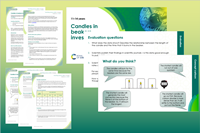Engage learners in the experimental process as they develop a hypothesis and plan an investigation
This resource accompanies the article Understanding the hypothesis, part of the Teaching science skills series, from Education in Chemistry.
Learning objectives
1 Make predictions using your scientific knowledge and use them to form a hypothesis.
2 Plan an appropriate investigation to test your predictions.
Introduction
Experiments ‘to show’ can be frustrating for learners if they already know what the experiment will show. The approach here is to change the experiment into one where they will not know what happens.
Learners have to use critical thinking to evaluate the alternative suggestions in the concept cartoon. They are then asked to formulate a hypothesis based on their own ideas about what will happen. They will need experimental data in order to test their prediction.
As learners are asked to plan an investigation to test their hypothesis they are prompted to think about what makes a fair test and how to get reliable data.
How to use the resource
This could be used to follow on from a class investigation into the effect of beaker size on the length of time the candle burnt. The slides can be used to guide a class discussion, in combination with or as an alternative to the worksheets. Give learners time to read the concept cartoon and consider their own ideas, then discuss and work towards agreeing on a hypothesis to test.
Alternatively, learners can work through the worksheet in groups, or independently as a homework task.
If the learners plan and carry out their own investigations this will be an activity for a whole lesson or even two. Otherwise all or part can be used as an activity at the start or end of a lesson.
There is an opportunity to evaluate some real experimental data (this might motivate learners to carry out the experiment to obtain better evidence). Learners are then asked to briefly think about the difficulties of showing only slight effects in results, as in medical research.
The follow-up task asks learners to use creative skills to produce their own concept cartoons. You can show learners more examples of concept cartoons from our collection.
Differentiation
This activity was created to be challenging, requiring learners to use critical thinking. By structuring as a class discussion you can use the discussion guidance in the teacher notes to offer prompts or ask questions to help guide learners needing more support. Alternatively, asking learners to work in small groups for some parts of the activity will give them a chance to support one another. More confident learners could complete the worksheet independently.
Answers and discussion guidance can be found in the teacher notes.
More resources
- Use research-based tips to help learners form scientific questions.
- Discover ideas for open investigations where learners can practise developing hypotheses with activities from In search of solutions.
- Explore the reactivity series of metals and displacement reactions with these experiments and videos for 14–16 students, use the pause-and-think questions to discuss what is being tested and why.
- Find out how senior principal scientist, Misbah uses computers to help make and test predictions about catalysts.
Downloads
Candle investigation: hypothesis and planning - presentation
Presentation | PowerPoint, Size 2.7 mbCandle investigation: hypothesis and planning - presentation
Presentation | PDF, Size 0.71 mbCandle investigation: hypothesis and planning - teacher notes
Editable handout | Word, Size 0.42 mbCandle investigation: hypothesis and planning - teacher notes
Handout | PDF, Size 0.17 mbCandle investigation: hypothesis and planning - student worksheet
Editable handout | Word, Size 0.48 mbCandle investigation: hypothesis and planning - student worksheet
Handout | PDF, Size 0.26 mb
Additional information
This resource was originally created by the author as part of our Chemistry for the gifted and talented collection. It has been updated and made more accessible.



















No comments yet